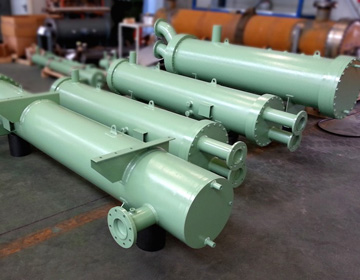Compare and contrast various heat exchanger designs
Introduction:
Heat exchangers play a crucial part in different industrial processes, encouraging the productive transfer of thermal energy between fluids. In any case, selecting the foremost appropriate heat exchanger plan for a particular application can be challenging due to the wide extend of accessible alternatives. In this blog post, we’ll Compare and contrast various heat exchanger designs to assist you make an educated choice based on your requirements.
Shell and Tube Heat Exchangers:
Structure: Consist of a shell (outer vessel) containing numerous tubes (inner tubes).
Performance: Offer high heat transfer effectiveness and flexibility, making them reasonable for a wide extend of applications.
Applications: Commonly utilized in power plants, chemical preparing, HVAC systems, and oil refineries.
Advantages: Can handle high-pressure and high-temperature liquids, simple to clean and maintain, and have a long benefit life.
Disadvantages: Higher beginning cost and bigger footprint compared to a few other designs.
Plate Heat Exchangers:
Structure: Comprise a series of layered metal plates stacked together with liquid channels then again formed between the plates.
Performance: Give productive heat transfer with a compact footprint, making them perfect for applications with space constraints.
Applications: Widely used in HVAC, refrigeration, food processing, and pharmaceutical businesses.
Advantages: Compact plan, high heat transfer coefficients, easy to introduce and maintain, and reasonable for applications with variable flow rates.
Disadvantages: Susceptible to fouling and corrosion, restricted to low to moderate weight and temperature applications.
Finned Tube Heat Exchangers:
Structure: Consist of tubes with expanded surfaces (fins) joined to the external surface, expanding the surface area accessible for heat transfer.
Performance: Effectively transfer heat between gases and liquids, commonly utilized in air conditioning and refrigeration systems.
Applications: HVAC systems, refrigeration, handle industries, and power generation plants.
Advantages: Improved heat transfer rates, compact plan, reasonable for air-to-fluid and fluid-to-fluid heat exchange.
Disadvantages: Prone to fouling and corrosion, constrained to applications with direct temperature differentials.
Conclusion:
Each heat exchanger plan offers interesting advantages and impediments, and the choice depends on factors such as operating conditions, space constraints, fluid properties, and budget considerations. By understanding the characteristics of distinctive heat exchanger plans, you can select the foremost suitable alternative to meet your particular application prerequisites and accomplish optimal heat transfer execution.

